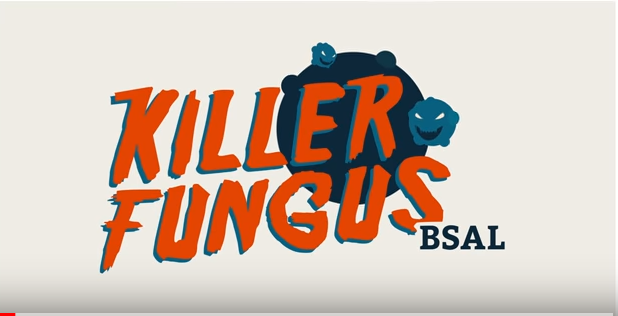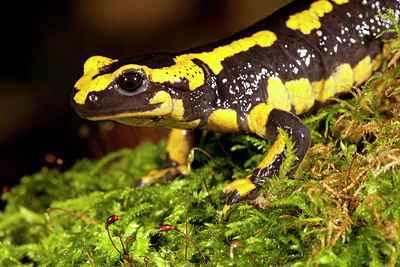Chytridiomycosis (Chytrid) has been responsible for mass mortalities of amphibians with declines and extinctions on six continents, including Europe.
Until recently, most pathogenic outbreaks of Chytrid were associated with the fungal pathogen, Batrachochytrium dendrobatidis (Bd). However, since 2013 a newly described species B. salamandrivorans ( = salamander-devouring ) known as Bsal, has been reported in northern Europe. This new form of chytrid has proven highly pathogenic to salamanders and newts, and devastated populations of wild living fire salamanders in the Netherlands and parts of Belgium and Germany, with reported declines of 99.9% over the period from 1997 - 2014.
Clearly, these are very worrying developments, and the further spread of this highly infectious pathogen could have a disastrous impact on salamanders and newts across Europe, including the UK. Therefore, it is essential to understand more about the nature of the threat, how it may affect our native newts and what we can do to prevent or contain it.
Research by colleagues in Europe, notably the research group at the University of Ghent led by Ana Martel and Frank Pasmans, and RAVON in the Netherlands, has established the following facts about Bsal:
- Bsal is a newly described form of the chytrid fungus that literally eats away at the skin of salamanders and newts.
- Salamanders and newts (Urodela) are extremely susceptible to Bsal, while other amphibians such as frogs and toads appear to remain unaffected.
- Infected salamanders and newts can show superficial skin erosion, deep ulcerations and skin necrosis. They can also appear listless and apathetic. The animals die relatively rapidly, in around 12-18 days.
- Some infected animals can also carry chytrid infection without signs of disease for weeks or months, during which time they are infectious to other animals.
- Bsal originates from Asia, but is believed to have arrived in Europe recently via the pet trade, particularly relating to the import of Asian salamanders.
- Asian salamander species have lived in coexistence with Bsal for millions of years and appear to carry the fungus with little or no ill-effect. Infection records from Asia date back to at least 1861.
- The mass transportation and importation of animals from Asia, has now resulted in mass mortality and severe population declines in wild fire salamander, smooth newt and alpine newt populations in the Netherlands, Germany and Belgium.
- The optimum growth temperature of Bsal is between 10-15˚C. This is lower than the optimum temperature for Bd (17-25˚C), which might be why it has proven a greater threat in our cooler northern climates.
- Bsal has also been detected in captive salamanders held in Germany and England
For more information and the latest news and updates go to: http://sossalamander.nl and watch this YouTube video
What can we do?
1. If you spot dead or dying amphibians, report these immediately through the Garden Wildlife Health Project (www.gardenwildlifehealth.org). Note down when, and where you saw the sick/dead animal and if possible submit photos of the animals showing the symptoms
2. Check and improve your biosecurity precautions - for more handy hints you can watch this short video
The full fact sheet can be downloaded from: www.gardenwildlifehealth.org
- Never release any (native or exotic) amphibians from captivity into the wild.
- Never transfer wild amphibians between sites. Do not stock ponds with spawn/tadpoles/adult amphibians – they will colonise new ponds naturally (and often surprisingly quickly).
- Do not assume that a healthy looking animal is free of infection; some animals can act as carriers without exhibiting signs of disease. Adopt the precautionary principle and manage all amphibians as if they are infected.
- Know the health status of your collection. Get your animals tested routinely and ensure any dead amphibians are submitted for post mortem examination. If dead animals are not submitted for testing, care should be taken when disposing of them. They should be incinerated or buried in such a way that scavenging animals cannot access them.
- Quarantine new arrivals and screen for chytrid infections on arrival. Any positive animals should be treated under veterinary supervision and test negative before being added to your collection.
- Avoid keeping amphibians in outdoor enclosures as they may come into contact with native wild amphibians and infect them with disease agents (even if the captive animals appear healthy).
- Do not clean tanks or vivaria outside where there is a possibility of contaminating areas used by wild animals. Disinfect all waste water from amphibian enclosures. Use a disinfectant such as Bleach, Virkon, F10 and Anigene following the manufacturers’ instructions. Once the water is disinfected it should only be discharged down a drain connected to a sewer.
- To avoid spreading disease within a collection, disinfect equipment between enclosures or have dedicated equipment for each enclosure. Equipment and furnishings should be regularly cleaned and disinfected, with waste water discharged into the sewer system.
- Substrates (soil, sand, gravel, etc.) can harbour infections and should be discarded carefully. Ideally these should be sent for incineration by a registered company that can dispose of clinical waste (e.g. those used by veterinary practices). If this is not possible, disinfect and dispose with the household refuse for collection by your local council.
- Register with a veterinary surgeon who has an interest in, and knowledge of, amphibians (see the special interest list on www.bvzs.org) and seek advice on keeping your collection healthy
3. Regulating the trade in salamanders and newts
Our colleagues at REPTA and OATA are issuing advice for the trade. Much of this is encapsulated under new UK Government legislation governing the import of live salamanders and newts.
https://www.gov.uk/government/publications/the-import-of-salamanders-and-newts
References
- Yuan, Z., Martel, A., Wu, J., Praet, S., Canessa, S., Pasmans, F. 2018. Widespread occurrence of an emerging fungal pathogen in heavily traded Chinese urodelan species. Conservation Letters. [Link]
- Stegen, G., F. Pasmans, B.R. Schmidt, L.O. Rouffaer, S. van Praet, M. Schaub, S. Canessa, A. Laudelout, T. Kinet, C. Adriaensen, F. Haesebrouck, W. Bert, F. Bossuyt, A. Martel A, 2017. Drivers of salamander extirpation mediated by Batrachochytrium salamandrivorans. Nature, Issue 544, pp 353-356. [Link]
- Fisher, M. C., 2017. Ecology: In peril from a perfect pathogen. Nature, Issue 544, 300-301. [Link]
- Spitzen-van der Sluijs, A., A. Martel, J. Asselberghs, E.K. Bales, W. Beukema, M.C. Bletz, L. Dalbeck, E. Goverse, A. Kerres, T. Kinet, K. Kirst, A. Laudelout, L.F. Marin da Fonte, A. Nöllert, D. Ohlhoff, J. Sabino-Pinto, B.R. Schmidt, J. Speybroeck, F. Spikmans, S. Steinfartz, M. Veith, M. Vences, N. Wagner, F. Pasmans & S. Lötters, S. 2016: Expanding distribution of lethal amphibian fungus Batrachochytrium salamandrivorans in Europe. Emerging Infectious Diseases: 22(7). [Link]
- Van Rooij, P. A. Martel, F. Haesebrouck & F. Pasmans, F. 2015. Amphibian chytridiomycosis: a review with focus on fungus-host interactions. Vet Res. 46. doi: 10.1186/s13567-015-0266-0. [link]
-
Martel, A., Blooi, M., Adriaensen, C., Van Rooij, P., Beukema, W., Fisher, M. C., Farrer, R. A., Schmidt, B. R., Tobler, U., Goka, K., Lips, K. R., Muletz, C., Zamudio, K., Bosch, J., Lötters, S., Wombwell, E., Garner, T. W. J., Cunningham, A. A., Spitzen-van der Sluijs, A., Salvidio, S., Ducatelle, R., Nishikawa, K., Nguyen, T. T., Kolby, J., Van Bocxlaer, I., Bossuyt, F. & Pasmans, F. (2014) Recent introduction of a chytrid fungus endangers Western Palearctic salamanders. Science 346, 630-631.


